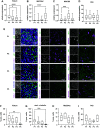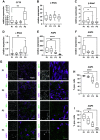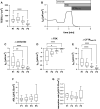Serially passaged, conditionally reprogrammed nasal epithelial cells as a model to study epithelial functions and SARS-CoV-2 infection
- PMID: 35196166
- PMCID: PMC8977148
- DOI: 10.1152/ajpcell.00363.2021
Serially passaged, conditionally reprogrammed nasal epithelial cells as a model to study epithelial functions and SARS-CoV-2 infection
Abstract
Primary airway epithelial cells (pAECs) cultivated at air-liquid interface (ALI) conditions are widely used as surrogates for human in vivo epithelia. To extend the proliferative capacity and to enable serially passaging of pAECs, conditional reprogramming (cr) has been employed in recent years. However, ALI epithelia derived from cr cells often display functional changes with increasing passages. This highlights the need for thorough validation of the ALI cultures for the respective application. In our study, we evaluated the use of serially passaged cr nasal epithelial cells (crNECs) as a model to study SARS-CoV-2 infection and effects on ion and water transport. NECs were obtained from healthy individuals and cultivated as ALI epithelia derived from passages 1, 2, 3, and 5. We compared epithelial differentiation, ion and water transport, and infection with SARS-CoV-2 between passages. Our results show that epithelia maintained major differentiation characteristics and physiological ion and water transport properties through all passages. However, the frequency of ciliated cells, short circuit currents reflecting epithelial Na+ channel (ENaC) and cystic fibrosis transmembrane conductance regulator (CFTR) activity and expression of aquaporin 3 and 5 decreased gradually over passages. crNECs also expressed SARS-CoV-2 receptors angiotensin converting enzyme 2 (ACE2) and transmembrane serin2 protease 2 (TMPRSS2) across all passages and allowed SARS-CoV-2 replication in all passages. In summary, we provide evidence that passaged crNECs provide an appropriate model to study SARS-CoV-2 infection and also epithelial transport function when considering some limitations that we defined herein.
Keywords: SARS-CoV-2; airway epithelial culture; conditional reprogramming; nasal epithelial cells.
Conflict of interest statement
No conflicts of interest, financial or otherwise, are declared by the authors.
Figures






Similar articles
-
Conditionally Reprogrammed Human Normal Airway Epithelial Cells at ALI: A Physiological Model for Emerging Viruses.Virol Sin. 2020 Jun;35(3):280-289. doi: 10.1007/s12250-020-00244-z. Epub 2020 Jun 17. Virol Sin. 2020. PMID: 32557270 Free PMC article. Review.
-
Inflammation in the COVID-19 airway is due to inhibition of CFTR signaling by the SARS-CoV-2 spike protein.Sci Rep. 2024 Jul 23;14(1):16895. doi: 10.1038/s41598-024-66473-4. Sci Rep. 2024. PMID: 39043712 Free PMC article.
-
Significant functional differences in differentiated Conditionally Reprogrammed (CRC)- and Feeder-free Dual SMAD inhibited-expanded human nasal epithelial cells.J Cyst Fibros. 2021 Mar;20(2):364-371. doi: 10.1016/j.jcf.2020.12.019. Epub 2021 Jan 5. J Cyst Fibros. 2021. PMID: 33414087
-
CFTR Modulation Reduces SARS-CoV-2 Infection in Human Bronchial Epithelial Cells.Cells. 2022 Apr 15;11(8):1347. doi: 10.3390/cells11081347. Cells. 2022. PMID: 35456026 Free PMC article.
-
How SARS-CoV-2 might affect potassium balance via impairing epithelial sodium channels?Mol Biol Rep. 2021 Sep;48(9):6655-6661. doi: 10.1007/s11033-021-06642-0. Epub 2021 Aug 15. Mol Biol Rep. 2021. PMID: 34392451 Free PMC article. Review.
Cited by
-
Modeling respiratory tract diseases for clinical translation employing conditionally reprogrammed cells.Cell Insight. 2024 Sep 18;3(6):100201. doi: 10.1016/j.cellin.2024.100201. eCollection 2024 Dec. Cell Insight. 2024. PMID: 39391007 Free PMC article. Review.
-
Passaging Primary Human Bronchial Epithelia Reduces CFTR-Mediated Fluid Transport and Alters mRNA Expression.Cells. 2023 Mar 24;12(7):997. doi: 10.3390/cells12070997. Cells. 2023. PMID: 37048070 Free PMC article.
References
Publication types
MeSH terms
Substances
Grants and funding
LinkOut - more resources
Full Text Sources
Medical
Miscellaneous

